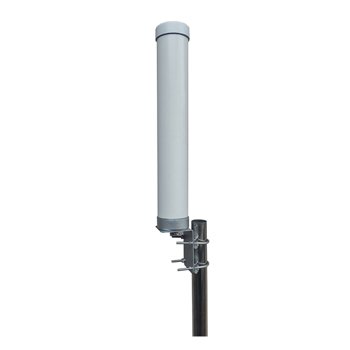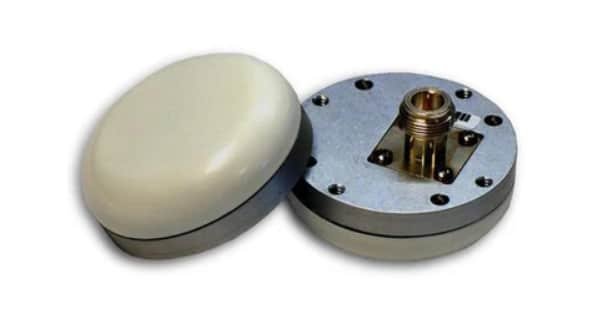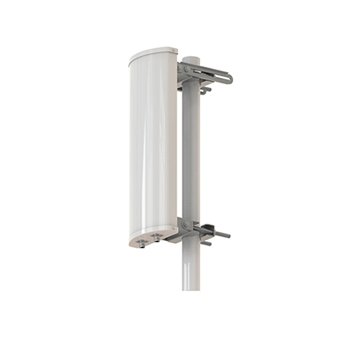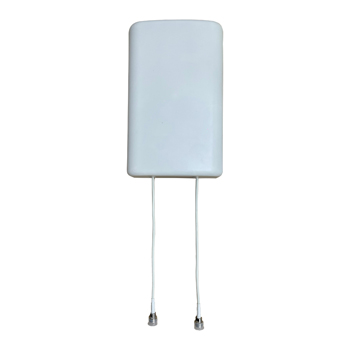
An omnidirectional WiFi antenna is a device designed to radiate and receive signals equally in all directions in a single plane, offering a 360-degree coverage area. This is ideal for applications that require the signals to reach all directions such as in homes, offices and public spaces. They are specifically useful for applications that prioritize widespread coverage over range or signal strength in a particular direction. Omnidirectional WiFi antennas are one of the best solutions to ensure that devices stay connected from any direction.
Table of Contents
ToggleHow omnidirectional WiFi antenna works
WiFi omni-directional antennas have multiple elements or dipoles arranged in a circular or spherical pattern around the antenna to radiate and receive signals in all directions. When a signal is transmitted from the antenna, these elements around it generate electromagnetic waves that propagate in all directions. These elements are arranged such that signals generated by them reinforce each other in the specific direction due to their phase differences. This improves the gain and efficiency of the antenna. Thus, omnidirectional antennas are able to transmit signals for 360 degrees around it within its coverage area enabling devices to connect to the WiFi network from any direction. Signal dropouts and network quality issues would be minimal as omnidirectional antennas do not require precise alignment for efficient functioning.
Types of omnidirectional WiFi antenna
- Fiberglass omni outdoor antenna
WiFi Omni Fiberglass Antennas are antennas designed to enhance the signal strength and coverage of WiFi networks. As the name suggests these antennas are constructed using durable fiberglass material which are weatherproof. This makes them ideal antennas to be used for outdoor applications. They are available in various performance configurations such as low gain, middle gain, and high gain and users can select the best fit depending on their requirements. Fiberglass omni antennas are easy to install and maintain as they can be conveniently mounted on poles or structures and they are compatible with most of the WiFi routers and access points available. These antennas are typically used for large outdoor applications such as parks, campuses etc. They are also used in marine applications, agriculture applications, industrial sites, to set up city wide WiFi networks, WiFi networks for rural and remote areas, event venues such as stadiums, convention centers, arenas etc.
- Rubber duck antenna
The WiFi Rubber Duck antenna is an omnidirectional WiFi antenna that looks like a rubber duck and like any other omnidirectional antennas, it is also capable of radiating signals in all directions. This type of antenna has 360 degrees coverage and hence is widely used in applications that require users to be detected from any direction. Rubber duck antennas are simple, easy to install, durable and cost effective. Rubber duck antennas are commonly used in IoT devices, home WiFi networks, mobile or portable applications, public WiFi hotspots at locations such as libraries, cafes etc. Because they broadcast in all directions, they can be more susceptible to interference from other devices operating on the same frequency and hence can lead to reduced performance in crowded environments.
- Ceiling mount antenna
Ceiling mount omnidirectional WiFi antennas are easy to mount on ceilings and are generally used for distributing cellular and WiFi signals throughout a building or area. They are easy to install and typically subjected to less interference. These antennas are also used for applications such as LoRA, LTE-M, and NB-IoT. In most use cases, ceiling mount antennas are used for indoor applications.
- Whip antenna
Whip omnidirectional WiFi antennas are cylindrical in shape and are available in different operating frequencies. They are used for different applications such as WiFi integrated security cameras, IoT devices, drones etc.
- Magnetic Mount Antenna
WiFi magnetic antennas are a type of omnidirectional antennas that can be easily attached to a metallic surface to enhance the WiFi signal reception. They are small, portable, easy to install and cost effective. They are typically used in applications such as attachments on vehicles to enhance theory signal reception, WiFi network for temporary setups such as events, trade shows, or temporary workspaces, in home and office WiFi networks etc.
Key Features of Omnidirectional Antennas
- Frequency Bands
WiFi omnidirectional antennas operate across different frequency bands and the most common frequency bands are the 2.4 GHz, 5 GHz, and the latest 6 GHz bands.
The 2.4 GHz Band is typically between 2.4 GHz to 2.5 GHz and has 11 channels in the United States, 13 in Europe, and up to 14 in Asia. Due to the low frequency and high wavelength, they are able to penetrate through obstacles better than other frequency bands and are generally compatible with most of the devices. But since this frequency band is used by other technologies like bluetooth and microwave communication as well, the network traffic will be congested and thus could lead to poor quality communication. The 2.4 GHz frequency band is ideal for general use cases such as web browsing, email, and IoT devices.
The 5 GHz Band is typically between 5.15 GHz to 5.85 GHz and has about 23 non-overlapping channels in the U.S. This frequency band has better data rates and less interference compared to the 2.4 GHz band and is less crowded. But since the wavelength is shorter, the penetration power is lower and could be easily attenuated by obstructions in the communication path. Older devices might not support the 5 GHz band. The 5 GHz frequency band is ideal for high-bandwidth applications like HD video streaming, online gaming, video conferencing etc.
The 6 GHz Band is typically between 5.925 GHz to 7.125 GHz and has a higher number of channels available. This frequency band has even better data rates and less interference compared to the 5 GHz band and is less crowded. But since the wavelength is shorter, the penetration power is even lower than for 5GHz and thus prone for interference even more. This band requires devices that specifically support the 6 GHz band. The 6 GHz frequency band is ideal for ultra-high-bandwidth applications and dense environments with a massive number of users.
- Gain (dBi)
The gain of a WiFi omnidirectional antenna is a measure of how effectively the antenna can direct signals in a particular direction compared to an ideal isotropic antenna that radiates equally in all directions. Omnidirectional WiFi antennas are available in different gain values. Typically high gain omnidirectional antennas will have a flatter, more compressed radiation pattern meaning that it can cover a larger horizontal distance but with reduced vertical coverage, making them ideal WiFi antenna options for applications such as in warehouses, open office spaces or outdoor environments. Lower gain omnidirectional WiFi antennas have a spherical radiation pattern with a greater vertical coverage and lower horizontal reach, thus making them a better option for applications like WiFi network in multi story buildings.
- Polarization
WiFi omni-directional antennas can have various types of polarization such as vertical polarization, horizontal polarization, slanted polarization or dual polarization.
In vertical polarization, the electric field of the signal wave is oriented vertically and is typically used in WiFi networks for urban or suburban areas.
In horizontal polarization, the electric field of the signal wave is oriented horizontally and is typically used in point to point applications.
In slanted polarization, the electric field is oriented at a positive or negative 45-degree angle and is typically used for either multipath environments or MIMO systems as the interference can be reduced and throughput and reliability can be improved.
In dual polarization, two of the types of polarizations mentioned above are combined together to maximize the use of spectrum and to improve the versatility of the network. This mode of polarization is used widely in modern networks such as MIMO systems and beamforming applications.
- VSWR (Voltage Standing Wave Ratio)
The Voltage Standing Wave Ratio (VSWR) is a measure of the efficiency of power transfer from the transmission line to the antenna. The lower the value of VSWR, the better the performance as the impedances match and the efficiency will be higher. The signal quality will also be better and the range and coverage area will also improve.
- Bandwidth and Efficiency
Bandwidth is a measure of the available spectrum and the throughput of the antenna. Wider bandwidths allow higher data rate and narrow bandwidths have limited performance. However, wider bandwidths are more susceptible for interference than omnidirectional WiFi antennas with narrow bandwidths. Antennas with wider bandwidth will have more channels for transmission and thus less traffic compared to narrow bandwidth antennas. Hence, omnidirectional antennas with wider bandwidths will have better performance in high dense environments with a massive amount of users.
Omnidirectional WiFi antennas are available in different efficiency levels. Antennas with higher efficiency have better performance with greater signal strength, higher reliability, effective power consumption and greater range and coverage area.
- Radiation Pattern
Omnidirectional antennas radiate signals in all directions and have a radiation pattern of a doughnut shape. Due to this radiation pattern they have a wide horizontal coverage area but limited vertical reach.
What is an Omnidirectional WiFi Antenna Used For?
Omni-directional antennas are used in a wide range of applications from residential and small office environments to large public areas with high density of users. Omnidirectional WiFi antennas are generally used for applications that require users to connect from all directions. Some of the most common use cases for omnidirectional WiFi antennas are discussed below.
- Home or Office WiFi Networks
Omni-directional WiFi antennas are used to extend the range of a home or office WiFi network such that the signals can reach all areas of the building. In larger buildings or offices, where a large number of users will be connecting to the network from all directions, it is essential to have an antenna that can reliably provide connectivity. For such use cases, omnidirectional antennas are ideal as they can be installed in a central location and provide coverage to all floors and areas without the need for multiple directional antennas.
- Public WiFi Networks
Omni-directional WiFi antennas are widely used to set up WiFi hotspots or public WiFi networks as they enable users to connect reliably from any direction even while moving around. They are typically used in public locations such as airports, cafes, libraries, shopping malls to provide WiFi access to a large number of users or devices.
- Outdoor WiFi Networks
Omni-directional WiFi antennas are commonly used to provide WiFi coverage in outdoor areas such as parks, stadiums, campgrounds, arenas etc. where a large number of users will be gathered and will access the network in multiple different directions. These antennas can even be used for complex applications like setting up city wide networks.
- Events and Festivals
Omnidirectional WiFi antennas can be used to set up wireless networks at events like concerts, festivals or sporting events. They are ideal to provide seamless connectivity to a large number of attendees in all directions.
- Wireless Internet Service Providers (WISPs)
Omnidirectional WiFi antennas are used by ISPs to provide internet access to customers across a wide area. Due to their radiation pattern, they are able to radiate the signals to a large coverage area.
Benefits of using an omnidirectional WiFi Antenna
Omnidirectional WiFi antennas are widely used across many applications due to the benefits they offer. Described below are few of the advantages in using omnidirectional WiFi antennas for wireless network setups.
- 360-degree coverage
Omnidirectional WiFI antennas are able to radiate and receive signals in all directions equally thus providing a 360-degree coverage pattern. This makes it possible to provide coverage to a large area without any requirement for manual alignment of the antenna or connecting devices.
- Ease of installation
Omnidirectional WiFi antennas are extremely convenient to set up as they do not require any special installation tasks. They require minimal steps and can be installed by anyone without requiring too much professional expertise as they do not need to be set up in specific orientations or alignments as a directional antenna.
- Support for Multiple Connections
Omnidirectional WiFi antennas are versatile devices as they can be used in various applications to receive and transmit signals in all directions. They can be used for both indoor and outdoor applications as well as for both static and moving applications. The ability to transmit and receive signals in all directions makes them useful for most applications like Wi-Fi networks, radio broadcasting, vehicles and ships etc.
- Consistent Signal Quality
Omnidirectional WiFi antennas are designed to simultaneously process signals from multiple directions. Thus, they are able to maintain high quality in strength even while transmitting and receiving signals from multiple devices. And they can receive signals from multiple sources simultaneously. As such, omnidirectional WiFi antennas are a great option for setting up networks in areas with multiple signal sources or in environments with a lot of interference.
- Low maintenance
Omnidirectional WiFi antennas are generally more cost-effective compared to directional antennas. They are simple in design and easy to install. They are easy to maintain as well since they do not require any special mechanisms for placement or alignment. Omnidirectional antennas are considered a budget friendly option for setting up WiFi networks.
Limitations of Omnidirectional WiFi Antennas
Although omnidirectional antennas are extremely useful, they can have certain limitations and drawbacks too.
- Limited range
Omnidirectional antennas have a limited range compared to directional antennas. Since they radiate signals in all directions, their strength of signal towards one direction will be reduced. Hence, omnidirectional antennas are not too suitable for long range communication.
- Interference
Omnidirectional WiFi antennas are subjected to obstacles and attenuation from all directions. Hence, they encounter more interference than directional antennas. They tend to be affected by nearby devices operating in the same frequency range and thus could have their overall performance impacted negatively.
- Lower gain
Since omnidirectional WiFi antennas distribute their energy in all directions, they generally have a relatively lower gain when considering a single direction. Most of these antennas tend to have a gain around 12 dBi although they have omnidirectional antennas with varied gains.
- Less focused coverage
Omnidirectional antennas radiate signals in a circular pattern and hence the focus of the signals radiated towards a specific direction can be less focused, leading to signal leakage and reduced efficiency especially in areas with more interference.
- Limited signal penetration:
Due to the lower signal strength in a particular direction, omnidirectional WiFi antennas can have difficulty penetrating obstacles such as walls, buildings etc. and the signals could be easily attenuated. Since these antennas radiate signals in all directions, their energy gets dispersed.
- Multipath interference
Omnidirectional WiFi antennas are subjected to multipath interference and this could lead to signal distortion and reduced performance especially in areas with obstructions through which signals can be reflected back in different directions.
Omnidirectional antenna vs directional antenna
As discussed throughout the article, omnidirectional antennas radiate signals in all directions providing 360 degrees coverage. Directional antennas on the other hand, radiate signals in a specific direction providing a focused high strength signal targeted in that direction. Omnidirectional antennas have better performance in terms of coverage area. However, directional antennas have superior performance when a single direction is considered, providing better signal strength, longer transmission distance, better data throughput and overall better quality of network. Based on their radiation patterns, omnidirectional antennas are better suited for applications that require the signals to be transmitted or received in all directions providing connectivity for users in all directions or for applications where the direction of the users vary constantly or are unknown.
In general, the decision between omni-directional and directional antennas depends on the requirements of the specific application.
Support for MIMO Technology
Omnidirectional WiFi antennas support MIMO (Multiple Input Multiple Output) technology. When omnidirectional WiFi antennas are used in MIMO configuration, they are able to facilitate higher data rates by transmitting and receiving signals in multiple data streams simultaneously. In MIMO setup, when multiple omnidirectional antennas are used it improves signal quality and reliability as well as the range it can reach. The impact of interference and obstacles will also be reduced. Omnidirectional WiFi antennas perform better in MIMO networks as they are able to make efficient use of the available spectrum and provide higher throughput with better stability. However, setting up these antennas in MIMO configuration is complex as it requires well thought out designing and implementation as well as requires proper maintenance. Using omnidirectional WiFi antennas with MIMO technology requires professional and technical expertise in antenna designing and networking. Thus, the cost will be higher too. For applications such as HD video streaming, online gaming smart home, and industrial IOT, omnidirectional WiFi antennas with MIMO technology will be ideal. Choosing between SISO and MIMO technologies depends on the requirements of the application.
How far will an omni-directional WiFi antenna reach?
The maximum distance that an omnidirectional WiFi antenna can reach varies depending on its design, the operating environment, the frequency band it operates in etc. Typically, they can reach up to several hundred meters which is sufficient for most of the general applications like home or office networks. These antennas provide coverage up to several hundred meters, sufficient for most residential and commercial applications. A key factor affecting the maximum reachable range of an omnidirectional antenna is the obstacles from physical structures or interference from other devices in similar frequency ranges occurring in the coverage area. In perfect conditions with minimal obstacles, they can even reach distances as far as several kilometers.
Installation Considerations
Similar to setting up any other type of antenna, several factors need to be considered when installing an omnidirectional WiFi antenna. It is important to consider the operating environment including the weather conditions and any physical structures that could be obstacles during signal radiation. Weatherproof omnidirectional WiFi antennas are also available. The coverage areas and the signal strength should be considered, clearly identifying any dead zones or areas with high interference and weak signal strength. It is crucial to identify the right locations for placing omnidirectional WiFi antennas evaluating all the performance requirements for the applications. It is necessary to consider the mounting options and the cables and connectors used for the installation. Generally, high elevation locations are better to mount these antennas as they are then subjected to less interference.
Conclusion
Omni-directional WiFi antennas are commonly used type of antennas for WiFi networks. These antennas are important as they can be used to set up networks for applications where the direction of users varies constantly, the direction is unknown or when users can be from multiple directions. This article discussed the pros and cons of omnidirectional antennas and provided a brief overview on some of the most common use cases. With proper understanding of the different performance parameters, the installation considerations and the different types of omnidirectional WiFi antennas available, it will be possible to select an optimal and ideal antenna for an application.








